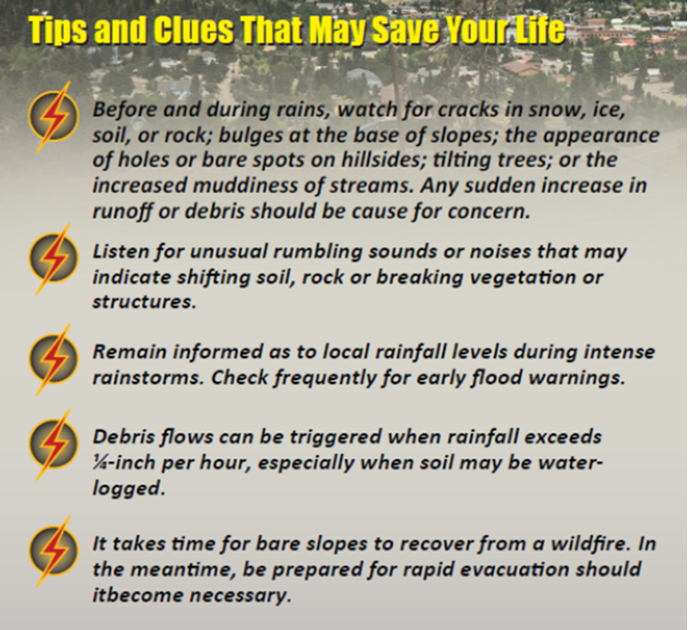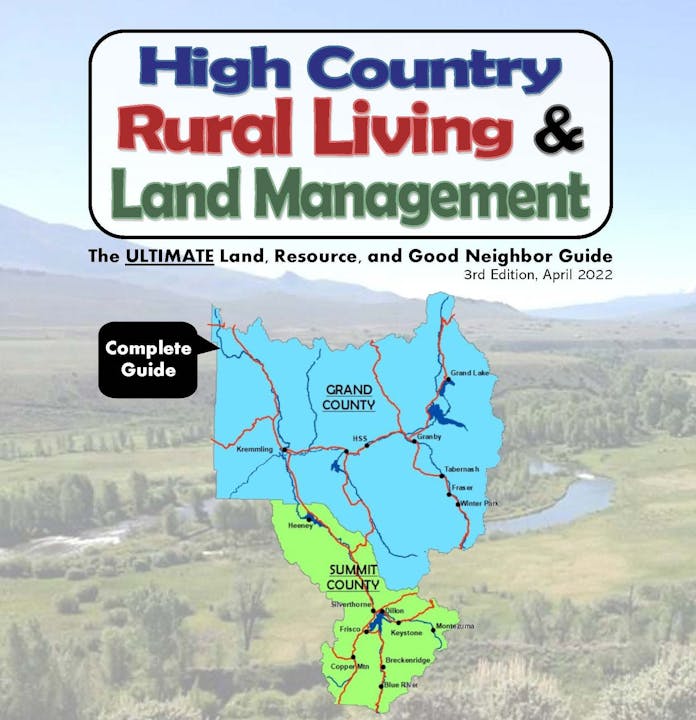Post-Fire Recovery Resources
Post-Fire Recovery Resources
After the East Troublesome Fire devasted over 193,000 acres of land in Grand County in October 2020, the Middle Park Conservation District developed a webpage full of Post-Fire Recovery resources and websites.
Check it out at: middleparkcd.com/wildfire-recovery-resources
Post-Fire Threats: Flood & Mud
Debris flows (commonly called mud slides, mud flows or debris avalanches) are shallow landslides that travel rapidly downslope as muddy slurries after being saturated with water. The flowing mud carries rocks, trees, and other debris as it pours down the slopes.
Sudden debris flows gushing down rain-sodden slopes and gullies are widely recognized as a hazard to human life and property. Most debris flows are localized in small gullies, threatening only those buildings in their direct path. Bare slopes left denuded by wildfires are especially susceptible to more catastrophic debris flows during and immediately after rainstorms. Mudslides and debris flows can also be exacerbated by the fact that high intensity fires burn with such heat that the organic matter in the soil sometimes melts and forms a waxy coating on the soil that prevents infiltration of rain water. This now “hydrophobic” soil has a reduced capacity to absorb and retain moisture. Debris flows often occur WITHOUT WARNING in areas where they have never been seen before.
Anyone living downslope of a burned area should be aware of this potential hazard. Following a fire and for at least 5-10 years thereafter, burned areas are far more susceptible to debris flows. Known to start on slopes as low as 15 degrees, more dangerous and faster moving debris flows are increasingly likely to develop the steeper the slopes. About two-thirds of all debris flows start in hollows or troughs at the heads of small drainages. Commonly, a debris flow will coalesce on a hillside and flow quickly downslope, inundating everything in its path. Topography controls a debris flow path just like moving water, so flows generally follow stream courses and spread out onto flatter depositional areas like alluvial fans where streams exit steep areas.
If you live in a mudslide prone area, the two most important actions taken on rainy nights are:
1) Heed flood warnings.
2) Do NOT sleep in lower-floor bedrooms on the sides of houses that face steep slopes or drainages.
Other Important Actions
- Check out Grand County's FLOOD READY guide
- Check out Colorado's Flood Threat Bulletin (updated daily)
- Sign up for CodeRED Emergency Alerts
- Read the Red Cross Info on Preparing for Landslides: redcross.org/get-help/how-to-prepare-for-emergencies/types-of-emergencies/landslide.html
- Consider getting Flood Insurance if your house is in the flood zone or could be threatened by flood.

References
- Colorado Geological Society's Post-Wildfire Hazards: Mud Slides-Debris Flows. http://www.middleparkcd.com/wp-content/uploads/2021/07/HAZ-2021-01-MudslidesDebrisFlows.pdf
- Grand County Office of Emergency Management. https://www.co.grand.co.us/floodready

